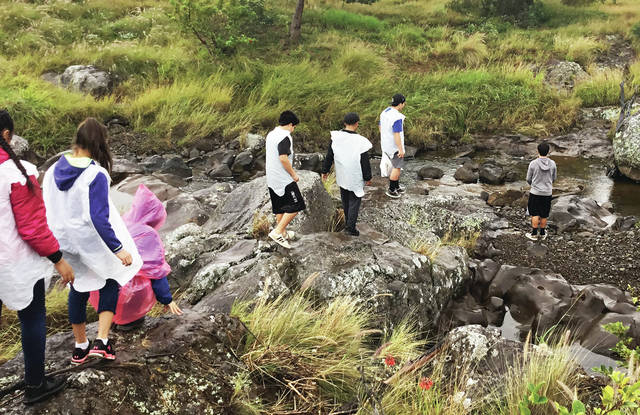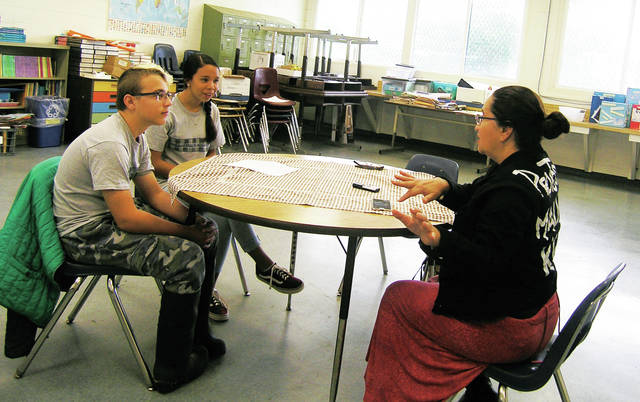WAIMEA — “Malama Ahupuaa,” the title of the latest Waimea Middle School oral history book, funded by Ike Hawaii and Hawaii Community Foundation, recently became available on Amazon. The book is the result of an oral history project conducted by Leesa Robertson’s Waimea Middle School seventh graders.
The oral history project was a component of an integrated curriculum approach to learning created by the seventh grade team for the 2017-18 school year, where all content areas were engaged in and intersected around the theme of “Malama Ahupuaa.”
“We took the three sections of our Lalamilo ahupuaa, or land divisions – makai (coastal), kula (mid-section) and mauka (mountain) – and focused our lessons and activities around life in those areas,” explained seventh grade science teacher Jade Bowman.
Students explored the different areas of the ahupuaa, collected data which was integrated into the math curriculum, studied the flora and fauna, and did service projects.
“We started with makai and learned about Kawaihae and Pelekane Bay. Students learned the history and the moolelo of the area and the connection between voyaging and the ahupuaa, and how what we do on land ultimately affects the ocean,” Bowman said.
There is much knowledge and wisdom in stories and, “Students learned the stories of the sections of the ahupuaa and wrote their own renditions of the myths. They learned the cultural significance of the plants and animals,” she added.
In Robertson’s class, a year-long oral history project explored malama ahupuaa through the eyes and voices of 11 community members. Working in teams, the students spent the first half of the year gaining the skills they would need by interviewing a peer and then a family member. They collected biographical data, researched and created a timeline and a question outline, and practiced interview protocol.
The interviewees ranged in age from 29 to 86 and came from a variety of backgrounds and experiences that gave students a glimpse into individual perspectives of how they malama – or cared for – the ahupuaa and how they connected to the land and to each other.
A sentiment expressed in some way by all of the interviewees was that to malama something, you need to really know it, observe it and experience it. Manny Veincent and Mahina Patterson, the oldest and youngest interviewees, respectively, shared that sentiment.
While working for Hawaii Fish and Game in the Pohakuloa area of Mauna Kea, Veincent spent time camping in the wilderness to monitor and capture geese for breeding.
“That area between the Mauna Loa and Hualalai mountains was where those geese were. In the dark you could hear them crying. After a while, your senses become like an animal. You knew where the birds were,” he said.
Before becoming an environmental education specialist for The Kohala Center, Patterson did conservation work in the same area. Growing up exploring the land around her neighborhood, her early experiences set her on a path to malama ahupuaa.
“My fondest memories are going into the pasture that borders the wet side neighborhoods. So every chance that I got I would go and explore in the pastures and the streams back there. But I looked it up as I got older and found out that the name of that stream is Lalakea and that it’s one of the streams that feeds Hiilawe (a many storied waterfall in Waipio),” she said.
Malama ahupuaa also means to take care of the culture, the people and perpetuate practices and protocols that will travel into the future as wisdom to guide those that come after.
Micah Komohoalii — kumu hula, cultural practitioner, another of the interviewees — shares his deep knowledge of the Waimea district through chants and hula in his halau and through community classes.
“My halau specializes in dances of our own backyard, of our ahupuaa. The only thing we learn in the halau are the chants of Waimea, chants of Waimea’s rain, its fog, its winds, its place here and the heiau, the alii that were here,” he explained.
The re-emergence of the canoe culture has been a guiding light for malama ahupuaa. Two of the interviewees, Maulili Dickson and Chadd Paishon, are mainstays of Hawaii Island’s canoe program whose guiding motto, coined by canoe pioneer Clay Bertelmann, raises awareness of the connection between the health of the canoe and the health of the island: He waa he moku, he moku he waa — meaning the canoe is the island, the island is the canoe.
As the canoe’s quartermaster, Dickson grew up on the ocean and providing food for his family, which eventually grew to include the ohana waa (canoe family). He is currently is working with the Haunana Ola program, whose goal is to provision Hawaii Island’s voyaging canoe, Makalii, with food grown on the island for a 30-day journey to Papahanaumokuakea Marine National Monument.
Paishon, who is a captain and Pwo navigator with Ohana Waa Makalii, is also working with the land crew of Haunana Ola and works to bring canoe culture into classrooms.
“For us, sustaining ourselves on the canoe, it really comes down to everyone that’s on the deck of the canoe understanding what they need to do and taking care of each other. If we can do those things on the deck of the canoe, then we should be able to do those same things when we’re home here,” he said.
Like the canoe, the island has finite resources and so many of the interviewees expressed malama ahupuaa in terms of only taking what you need and sharing the abundance. Born and raised in Waimea, Lloyd Case grew up with that awareness.
“Don’t take more than you need. Leave something for others. We only take what we need from the ocean and the mountain because we practice the Hawaiian style,” he said.
Hawaii Community Foundation funded costs to transcribe the interviews and Ike Hawaii covered publishing costs. To read more stories of malama ahupuaa, the book will be available at Thelma Parker Library and is currently available on Amazon.com.


